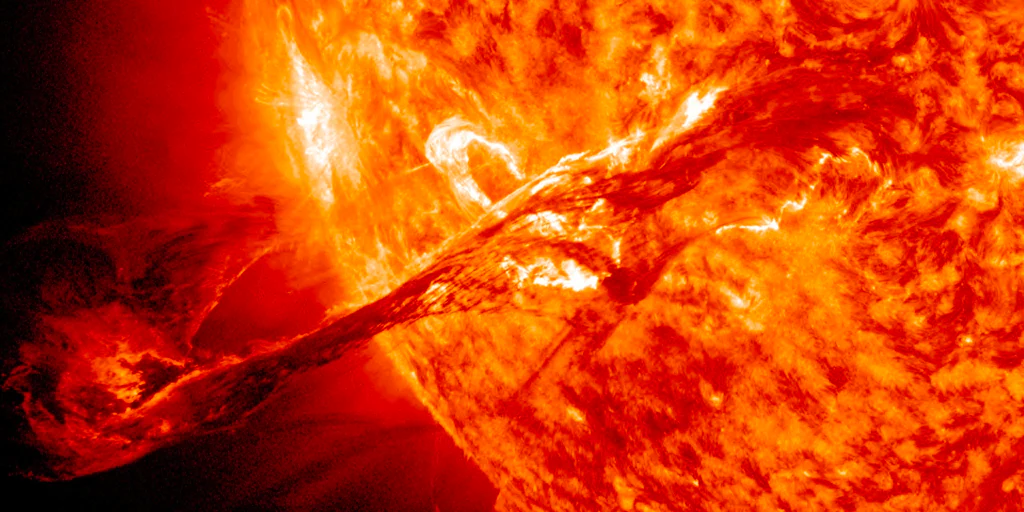The worst is yet to come

Without a doubt. 2024 will be a privileged year in terms of large-scale space shows. The first was a total solar eclipse in early April that left half the world gaping while the other half devoured images and videos of the eclipse. … event. And then, just a few days ago, and again with the Sun as the protagonist, a huge sunspot on its surface caused solar storms of unusual intensity, so strong that the northern lights left their classic polar setting to be seen on an incredible scale. latitudes as far south as Mexico or Spain.
The largest of them, the event of May 8, was truly colossal by all criteria, both on the five-level scale that characterizes the strength of these phenomena and in which it appears as “extreme”, and on the index of changes in the earth’s atmosphere. magnetic field, which called it a “superstorm”.
The event on the 8th was the first extreme G5 geomagnetic storm since 2003, according to the Space Weather Prediction Center (SWPC). The storm affected radio and GPS systems around the world, including the tycoon’s Starlink satellite communications system. Elon Muskwhich depends on 5,000 satellites in orbit and has experienced a “temporary degradation” of signals.
Preparing for the worst, power grid operators, the other main victims of severe space weather, also took various measures in many countries, leading to a complete system shutdown in New Zealand. It is not for nothing that geomagnetic storms can “inject” additional electrical currents into the network, causing power outages and, in the worst case, burning out expensive and difficult to replace electrical transformers, without which large geographic areas would be left for months. .whole without electricity.
When is the next one?
However, in this case there was no serious damage, but scientists and the public are wondering whether it could happen again with greater intensity in the coming months. We must not forget, experts say, that the maximum point of activity of this solar cycle (number 25) is already very close, and it is quite possible that the worst is yet to come.
According to the journal Nature, the European Space Agency’s Solar Orbiter probe is now almost behind the Sun, which will allow it to observe the storm from a very different perspective than what we see from Earth. And active region 3664, responsible for the storms that occurred a few days ago, is now “rotating” towards the hidden side of our star (the Sun rotates every 27 days), so that it will disappear from our field of view, but it will come right into the field of view of Europe ship. “In the coming days, we should have a better idea of whether this sunspot intends to continue hitting the other side of the Sun,” says David Williams, one of the spacecraft’s instrument scientists. But nothing is certain.
NASA’s Parker Solar Probe could also provide an additional perspective of the huge sunspot and perhaps provide valuable data in this regard, but the “batch” surprised it at the farthest point of its orbit, meaning it may take some time to obtain its data. time. reach Earth. Time we may not have.
On the other hand, NASA’s Maven spacecraft currently orbiting Mars could provide interesting data as a coronal mass ejection is expected to impact the Red Planet in the coming days.
But a little more can be said about this. And if the sun has prepared a great storm as a farewell to this cycle, this is something that scientists cannot know. In fact, this could happen at any moment. The current solar cycle is expected to peak sometime this year, and this prediction follows from a large number of Sunspots which have been observed in recent weeks. It is also known that the largest storms usually occur several months, or even years after this “peak” of activity, which is reached once every 22 years. To make matters worse, as the solar cycle progresses, the spots tend to appear closer to the solar equator, increasing the likelihood that coronal mass ejections will be directed directly toward Earth rather than into space.
What remains in the collective memory is what was the largest solar storm recorded in historical times, the Carrington Event, which in 1859 released so much energy into the atmosphere that telegraphs (the largest electrical system at the time) spontaneously caught fire. If something like this were to happen now, in a society that depends on electricity for communications, transportation, health care and the economy, the consequences would be incalculable.
Will something like this happen again? The answer is a resounding yes.. But when? It is difficult, almost impossible to know. The only thing we know for sure is that when it happens, we must be ready, and the truth is that although efforts are increasing, we are still very far from there.